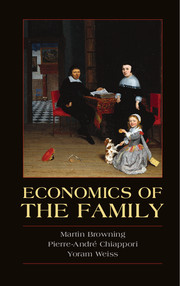Book contents
- Frontmatter
- Contents
- List of Tables
- List of Figures
- Acknowledgments
- Introduction
- PART I MODELS OF HOUSEHOLD BEHAVIOR
- PART II EQUILIBRIUM MODELS OF THE MARRIAGE MARKET
- 7 Matching on the Marriage Market: Theory
- 8 Sharing the Gains from Marriage
- 9 Investment in Schooling and the Marriage Market
- 10 An Equilibrium Model of Marriage, Fertility, and Divorce
- 11 Children and Family Structure
- Author Index
- Subject Index
11 - Children and Family Structure
Published online by Cambridge University Press: 05 July 2014
- Frontmatter
- Contents
- List of Tables
- List of Figures
- Acknowledgments
- Introduction
- PART I MODELS OF HOUSEHOLD BEHAVIOR
- PART II EQUILIBRIUM MODELS OF THE MARRIAGE MARKET
- 7 Matching on the Marriage Market: Theory
- 8 Sharing the Gains from Marriage
- 9 Investment in Schooling and the Marriage Market
- 10 An Equilibrium Model of Marriage, Fertility, and Divorce
- 11 Children and Family Structure
- Author Index
- Subject Index
Summary
Introduction
There is a growing concern that the higher turnover in the marriage market causes more children to live with single mothers or stepparents. In the United States in 2005, 68 percent of children younger than 18 years old lived with two parents (including stepparents), 23 percent lived only with their mother, 5 percent lived only with their father, and the rest lived in households with neither parent present. There is substantial evidence that children of divorced parents do not perform as well as comparable children in intact families. However, such empirical evidence does not necessarily imply a causal relationship. Indeed, Bjorklund and Sundstrom (2006) argue that inferior performances of divorced children can be attributed largely to selection effects.
The purpose of this chapter is to examine in more detail the impact of marriage and divorce on children. In particular, we wish to discuss the determination of expenditures on children and their welfare under various living arrangements, with and without the intervention of the courts. We take into account that parents continue to care about their natural children following separation, which may induce voluntary commitments of child-support transfers from fathers to their custodial ex-wives in the event that she remain single. Such conditional transfers can increase the bargaining power of the mother on remarriage and thus benefit the children. We then show that exogenous shocks that raise the divorce rate can increase the welfare of the children and their mothers because they provide incentive to fathers to raise their commitments.
- Type
- Chapter
- Information
- Economics of the Family , pp. 438 - 470Publisher: Cambridge University PressPrint publication year: 2014



